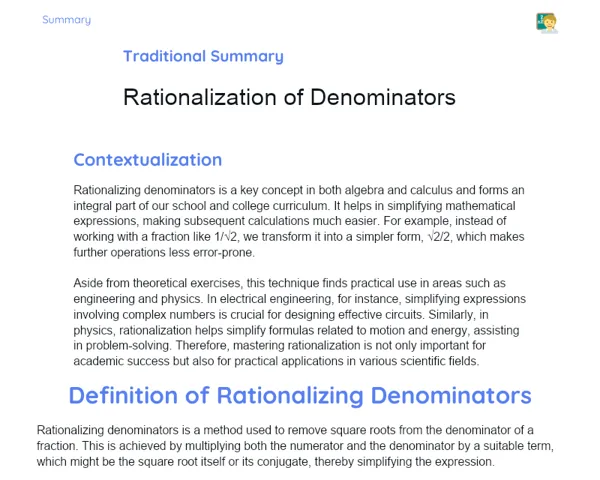Socioemotional Summary Conclusion
Goals
1. Learn how to convert fractions into decimals and back.
2. Apply these conversion techniques in everyday scenarios.
3. Enhance socio-emotional skills like concentration and teamwork during lessons.
Contextualization
Ever wondered how fractions and decimals pop up in our daily routines? Whether it's sharing a tasty cake among family or figuring out discounts while shopping at the mall, understanding these conversions makes life simpler and a bit more fun. Let’s dive into how this process works and see how it can help simplify our daily calculations!
Exercising Your Knowledge
Understanding Fractions and Decimals
A fraction represents a part of a whole, made up of a numerator and a denominator. On the other hand, decimals are numerical representations based on powers of 10. Both forms are widely used in mathematics and in practical situations we encounter every day.
-
Fraction: Shows a part of something by using a numerator and denominator.
-
Decimal Number: Another way to represent parts of a whole using the base 10 system.
-
Relevance: Both methods are integral to solving everyday problems and understanding basic math.
Converting Fractions to Decimals
Turning a fraction into a decimal is straightforward: simply divide the numerator by the denominator. This technique is particularly useful when you need to make quick calculations, such as while shopping or measuring ingredients.
-
Conversion Process: Divide the numerator by the denominator.
-
Practical Example: Converting 3/4 results in 0.75.
-
Utility: Helps in quick and accurate computation in day-to-day life.
Converting Decimals to Fractions
To convert a decimal to a fraction, identify the place value of the last digit and write the decimal as a fraction with the corresponding power of 10 in the denominator. Remember to simplify the fraction to its lowest terms for ease of use.
-
Identifying the Decimal Place: Check if the number lies in the tenths, hundredths, etc.
-
Creating the Fraction: Write the decimal with the proper power of 10 as the denominator.
-
Simplification: Reduce the fraction by dividing both the numerator and denominator by their greatest common divisor.
Key Terms
-
Fraction: A way of representing a part of a whole, written as numerator/denominator.
-
Decimal Number: A number based on the base 10 system that's used to denote parts of a whole.
-
Conversion: The process of changing fractions into decimals and vice versa, crucial for solving various mathematical problems.
-
Simplification: Reducing a fraction to its simplest form by dividing both numerator and denominator by their greatest common divisor.
For Reflection
-
How did you feel while working on these conversion problems? Was there any moment you felt stuck or uneasy?
-
How did you and your classmate work together to solve these problems? Were there any particular strategies that worked well?
-
Can you think of a scenario in daily life where converting between fractions and decimals would be handy? How might you use this knowledge in real-life situations?
Important Conclusions
-
Understanding how to convert between fractions and decimals is a vital skill for everyday use.
-
Being able to switch between these forms makes tackling everyday problems much easier.
-
Developing socio-emotional skills like cooperation and focus helps us handle mathematical challenges better.
Impacts on Society
In day-to-day activities, knowing how to convert fractions to decimals and vice versa can be very useful. For example, while shopping in local markets, understanding these conversions can help you quickly calculate prices and save both time and money. Similarly, when sharing food with friends or family, this skill ensures an equal division, promoting fairness and mutual respect. On a broader scale, these mathematical skills are valued in professional fields such as finance, engineering, and various sciences. Mastery over these conversions not only prepares us for academic pursuits but also for future career opportunities that demand accuracy and numerical agility.
Dealing with Emotions
While learning fractions and decimals, try following the RULER method at home. Begin by recognizing your emotions; think about whether you felt frustrated, confident, or calm during your practice. Reflect on what might have triggered those feelings – was it a tricky problem or distractions around you? Clearly naming your emotions, like saying ‘I felt anxious because I couldn’t solve that problem quickly,’ can help. Express your feelings appropriately, and if necessary, seek help or take a short break. Lastly, regulate your emotions by taking deep breaths, reassessing your study plan, and reminding yourself that challenges are a natural part of learning. Stay positive and persistent!
Study Tips
-
Take short breaks during your study sessions to keep your mind fresh and alert.
-
Practice converting fractions to decimals and vice versa using everyday examples, like prices or food portions.
-
Consider forming a study group with friends to share ideas and solve problems together; this shared learning can be both engaging and effective.



